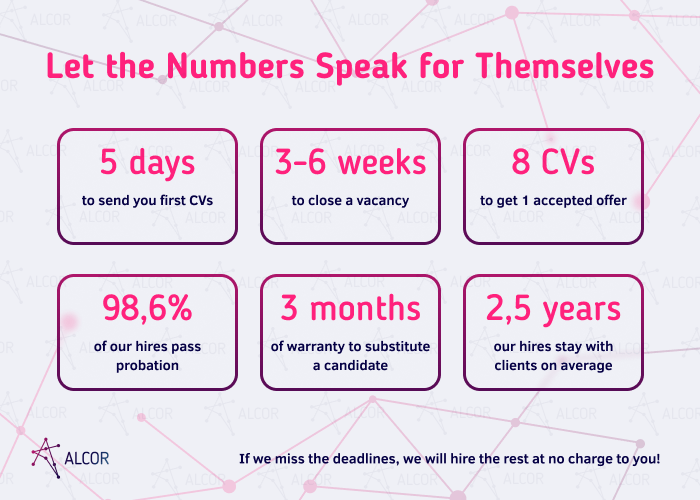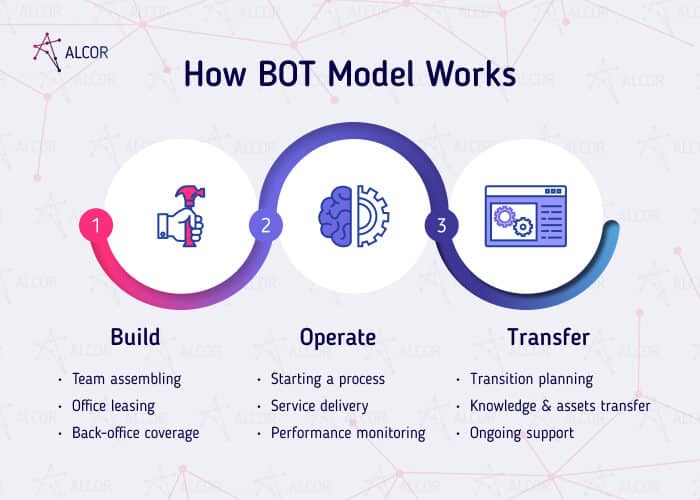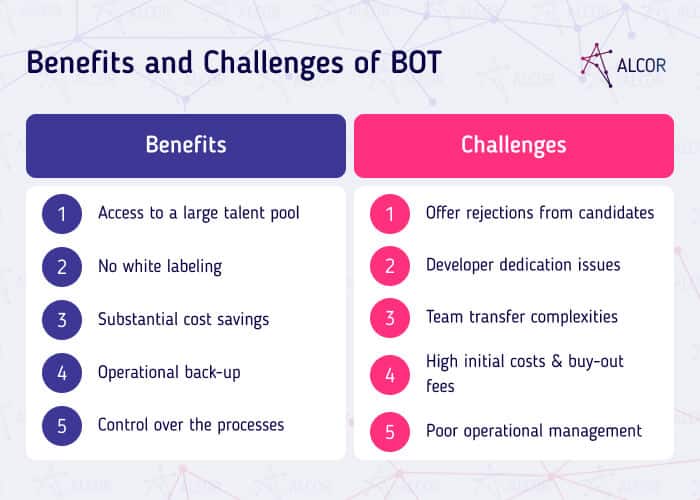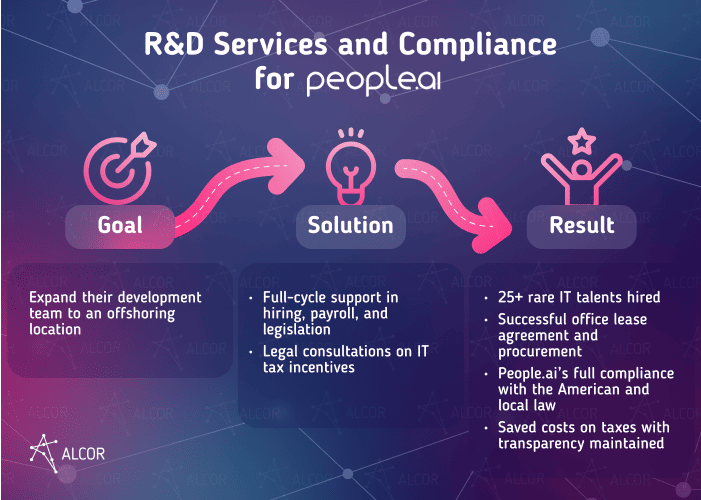The IT industry is advancing “at the speed of light” and offers exciting technologies and innovations for business growth. However, some IT companies lack internal resources to keep up with this pace and put themselves at risk of lagging behind their competitors. Cooperation with offshore or nearshore providers might be worth the candle if you don’t want to be in their ranks. Yet, with various engagement models available — the Build-Operate-Transfer, Managed Services, and IT staff augmentation — choosing the right one for your company is vital. So, how do you make the right choice?
I’m Sergiy Ovcharenko, CBDO at Alcor, a leading R&D center provider in Eastern Europe and Latin America. In this article, I’ll dive into the specifics of the Build-Operate-Transfer Model — exploring its pros and cons, variations, and tips on selecting a reliable partner. Additionally, I’ll introduce a compelling alternative to this business model. Let’s jump in without further ado!

What is a Build-Operate-Transfer Model?
Build-Operate-Transfer (BOT) is a business model (and a kind of project financing approach) that aims to build a software development team in a foreign location. To do so, IT companies partner with a local BOT service provider that oversees an offshore unit establishment, all the back-office services, and product development. At the conclusion of the partnership, the entire subsidiary with the development team and intellectual property is transferred to the client.
How Does a BOT Model Work in IT Outsourcing?
As its name suggests, the BOT model in the IT industry unfolds in three main stages:

1. Build
The first stage of this model spans around the creation of a client’s subsidiary in the chosen offshoring location. It presupposes the following steps:
- Team assembling. To get the ball rolling, the service provider performs IT staffing via the Build Operate Transfer model to build a development team tailored to your project’s needs. This may presuppose hiring additional staff which can sometimes be time-consuming.
- Office leasing. Simultaneously, the offshore provider secures office premises that will evolve into the R&D center for product development.
- Back-office coverage. To ensure the seamless functioning of the development team, the BOT vendor manages legal, employment, and payroll matters. Additionally, they handle the setup of the IT infrastructure to support operations.
2. Operate
Then, the BOT partner assumes the day-to-day operations, team management, and project supervision. The Operate stage involves the following activities:
- Starting a process. With the team in place and the infrastructure ready, the third-party vendor initiates the development process. This involves effective team management, organizing workflows, and progress tracking.
- Service delivery. The focus during this stage is on delivering top-notch services to the company. The BOT partner adheres to service level agreements, maintains operational efficiency, and continually enhances service delivery based on feedback and industry trends.
- Performance monitoring. The BOT partner diligently monitors project progress by keeping an eye on key performance indicators (KPIs) and implementing metrics to assess operational effectiveness. They provide regular reports that highlight areas for improvement and propose optimization strategies. This stage ensures a proactive approach to project management and continuous performance enhancement.
3. Transfer
The final act in the BOT collaboration is like passing the baton from the third-party vendor to the client. Let’s break it down:
- Transition planning. In this crucial phase, the BOT service provider meticulously plans the transition of operational responsibilities, assets, and knowledge back to the client. This involves outlining a comprehensive roadmap for a seamless handover.
- Knowledge & assets transfer. The partner company ensures the client’s team is well-prepared to take over the ongoing product development. They don’t just stop at skills and knowledge; it’s also about handing over the keys to the kingdom – physical assets, intellectual property, and operational contracts. This process involves legal and financial assistance to ensure compliance with relevant regulations.
- Ongoing support. Even after the transfer is in the bag, the BOT partner stays in the wings, offering support during the initial transition. They remain accessible for consultations and troubleshooting, ensuring a smooth and supported transfer of ownership. This ongoing support underscores the commitment to the client’s success beyond the formal handover.
Build-Operate-Transfer Examples in IT Industry
A compelling instance of the BOT model in software development involves a leading electrification and automation technology provider collaborating with a BOT service provider. The former wanted to step away from traditional IT outsourcing to establish their own remote software development team abroad via the BOT model. Eventually, this strategic move resulted in the successful recruitment of the required programmers and substantial cost savings for the client. Although the transfer stage took several years, the BOT model proved to be a mutually beneficial solution for both the client and the service provider. When the decision was made to finalize the transfer, the transition was remarkably smooth, and all software engineers seamlessly became official employees of the client.
In another Build-Operate-Transfer model scenario, a software engineering company embarked on a journey with multiple vendors for several years. The build and operate stages turned out to be a success, but the company faced certain issues when it came to the last step of transfer. Resources needed to be smoothly transitioned back from the BOT vendor, and the client opted to establish their own subsidiary in the BOT location for enhanced team supervision. Fortunately, the client wisely selected a competent R&D center provider, successfully addressing these challenges.
5 Benefits of Build-Operate-Transfer Model for IT
To see what exactly you will receive from BOT, I’ll cover both the advantages and disadvantages of this model. Firstly, let’s look at its key benefits:
1. Access to the large talent pool
If you’re based in the United States and have faced the challenge of talent shortage, then you’re probably in the 69% of American tech companies that struggle to find new employees. This is a huge stumbling block to effective team expansion for SMBs and enterprises alike.
The Build Operate Transfer in software development opens the door to a huge tech talent pool in distant and nearshore locations. For example, there are about 1.5 million software engineers in Eastern Europe and over 1 million programmers in Latin America. Beyond that, most of them are college graduates from the leading STEM universities with exceptional technical skills in JavaScript, Java, Python, TypeScript, PHP, C#, and C++ and high English proficiency who will gladly apply their knowledge to your product.
2. No white labeling
Compared to an outsourced team, a Build-Operate-Transfer agreement software team is your employees who work under your brand from the beginning. They will not develop a product and then just let you rebrand it. Developers hired through a BOT provider are essentially an extension of your in-house team — they’re the peas in your pod, dedicated to your product’s success. The only distinction is their geographical location; otherwise, they’re in the same boat, which boldly rows towards triumph.
3. Substantial cost savings
Creating your R&D office via the Build-Operate-Transfer model abroad is a viable way to save costs on developers’ compensation. For instance, the average senior developer salary in Mexico ranges from $58,000 to $70,000 a year. In Romania, experts of the same level earn from $46,000 to $75,000 annually. But this number breaks all records in the USA — from $78,000 to $170,000 per year. This allows US IT companies to save up to 60% on programmers’ salaries.
But that’s not all. You can also considerably benefit from the B2B employment of software developers in LATAM and Eastern European countries, where the income taxes span from 8,5% to 30%, depending on the offshoring location.
4. Operational back-up
When you partner with an IT vendor in the offshoring country, they become your one-stop shop for everything administrative. It’s like having a reliable co-pilot — they handle everything from recruiting software developers and managing payroll to negotiating office leases and offering tax consulting.
But that’s not all – legal matters are covered too. Lawyers well-versed in international IT law ensure your offshore branch complies with all regulations. They go the extra mile by preparing the necessary documents for a seamless R&D transfer. This comprehensive support means you can kick back a bit. With your IT vendor taking care of the nitty-gritty operational details, you’re free to steer your focus where it matters most – your core business.
5. Control over the processes
Another advantage of the Build Operate & Transfer solution is staying closely involved in the development process — a level of engagement often unachievable with traditional outsourcing practices. Agreeing with your BOT partner on the operational structure and development processes will give you peace of mind about proper task fulfillment. Once the transfer phase is over, you will get a team that is perfectly aligned with your business processes.
To see what exactly you will receive from BOT, I’ve listed the top five Build-Operate-Transfer services benefits that often make CTOs go for offshoring:
5 Challenges of Using the BOT Model for IT Outsourcing
Even though you can reap certain benefits of BOT, here are the five difficulties that you need to ponder:
1. Offer rejections from candidates
When venturing into a new offshore location, your company may face challenges where candidates hesitate to apply to your vacancies or accept job offers. This is a common problem among new companies on the market. Why? Because if candidates don’t know a thing about your business, they’re unlikely to add such working experience to their resume.
The only way to deal with this issue is through powerful employer branding. A successful Build-Operate-Transfer model in the IT industry involves partnering with a vendor that incorporates employer branding into your offshore strategy. This means your local partner launches a comprehensive branding campaign that includes creating company profiles in the local tech media, promoting your unique EVP, launching successful PR and SMM campaigns, and integrating your corporate culture.
The problem is that only a tiny part of Build-Operate-Transfer (BOT) providers offer this option. A real-life example is the case of the US-based IT company Tonic Health. Several years ago, they decided to expand to the Eastern European market to onboard 5-6 developers each month. However, their journey encountered unexpected turbulence – frequent rejections of job offers. The heart of the matter? A lack of company promotion in this new market. It turned out that developers were hesitant to join an unfamiliar IT company. Tonic Health teamed up with Alcor for a powerful employer brand campaign, a comprehensive strategy that included savvy social media marketing. The result? Not only did the company meet its initial hiring goal, but they also secured a fully-fledged R&D office.
2. Developer dedication issues
In Build-Own-Transfer (BOT), ownership matters from the get-go. If the structure isn’t yours right from the start, you might encounter challenges with your BOT team’s dedication to your company and product. Some BOT providers don’t recruit software engineers directly to your company but assume the role of an employer. Sometimes, they even try to interfere with product development and team management. So, developers might be confused about whom to report. In the ideal scenario, decision-making about your R&D facility should stay in-house. You want to ensure your BOT provider doesn’t have access to your core code and sensitive data.
3. Team transfer complexities
Moving operations and talent in a Build-Own-Transfer (BOT) model isn’t a swift sail; it’s often a time-consuming and intricate journey. Initial challenges arise during the skills and knowledge transfer phase, where effective communication is crucial for the client’s team. There is also a risk of losing some personnel and experiencing a temporary decrease in team productivity due to the changes introduced during the transfer.
In addition, the transfer process can be complex from a legal standpoint. These include compliance with local laws and regulations, data protection and privacy regulations, licensing of intellectual property, signing non-compete and non-disclosure agreements, etc. It’s essential to conduct thorough due diligence before and during the branch transfer process. This involves a comprehensive assessment of legal, financial, operational, and strategic factors to identify potential challenges and opportunities.
4. High initial costs & buy-out fees
The implementation of the Build Operate Transfer in software engineering often demands substantial upfront investments. These may encompass expenses such as office lease, infrastructure development, equipment procurement, and the setup of operations.
Another financial consideration is the buy-out fees incurred during the transfer stage. This involves payments for each software developer being transferred and will potentially transform the initially cost-effective endeavor into a substantial financial burden, especially for smaller companies.
5. Poor operational management
A common misconception is that only providers offering professional IT services, such as custom software development and testing, can effectively execute the Build Operate Transfer (BOT) engagement model. However, these firms may lack the expertise in building and running R&D offices, which involves substantial administrative support. To ensure your investment in offshoring is effective and well-spent, selecting a vendor with practical experience in establishing R&D offices tailored to companies like yours is crucial. Discover how to make the right vendor choice by continuing to read this article.

3 Opportunities When Using the BOT Model
-
Global expansion
In the ever-changing IT landscape, prompt team enlargement is critical for companies to stay ahead of the curve. However, the pressing problem of talent shortage and rising costs can potentially affect your business growth and competitiveness. In this regard, the BOT model can become the magic pill, allowing tech businesses to enter new markets and tap into their vast potential.
-
Technology adoption
Staying abreast of innovations is paramount, but access and resources can be limiting. Collaborating with an offshore BOT partner is a game-changer, as these service providers are often at the forefront of industry trends. This cooperation empowers tech companies to embrace cutting-edge technologies and best practices without hefty investments.
-
Focus retention
The BOT model liberates tech companies from secondary tasks. Instead, it allows them to focus on top-priority activities and long-term business objectives. With more resources from the BOT partnership, IT companies can accelerate their time-to-market, ensuring a sharper competitive edge.
3 Threats of Build-Operate-Transfer
-
Contractual risks
Working with service providers introduces the risk of encountering contractual pitfalls, such as financial issues, IP ownership, KPIs, confidentiality terms, force majeure, and termination aspects. Navigating these legal and contractual intricacies during BOT agreement negotiation and project execution is crucial to prevent disputes and delays.
-
Dependency on a service provider
Heavy reliance on the service provider for critical project aspects, including development, operation, and maintenance, poses a risk. If the relationship deteriorates or the transfer stage is mishandled, this dependency can become a threat to the project’s success.
-
Long-term financial commitment
Engaging in a BOT model involves a long-term financial commitment, particularly during the operating phase. IT companies may encounter challenges if unexpected financial pressures emerge or if the cost structure becomes unsustainable. Despite aiming for cost predictability, there’s a risk of cost overruns, especially in the face of unforeseen project challenges.
Variations of the BOT Model for the IT Industry
Build-own-operate (BOO)
The BOO model is a versatile project delivery and financing approach utilized across industries, including the IT sector. In this model, a company or entity designs, builds, and operates a specific system, facility, or infrastructure. What sets the BOO model apart is that the entity maintains ownership of the project not only during construction but also throughout the operational phase. This fundumental distinction separates it from the Build-Operate-Transfer (BOT) model.
Build-own-operate-transfer (BOOT)
The BOOT model is a prevalent project delivery and financing framework commonly utilized in infrastructure and public-private partnership (PPP) projects. It finds frequent application in scenarios where private sector involvement is sought to fund and develop public infrastructure. In the IT industry, the BOOT model might be employed to develop, operate, and transfer IT infrastructure, systems, or platforms.
The main difference between the BOT and BOOT models lies in the ownership during the operational phase. In the later, the service provider not only builds but also maintains ownership of the facility and IT infrastructure. This ownership aspect can introduce additional complexities during the transfer phase to the client.
Build-lease-transfer (BLT)
The BLT model is a project delivery and financing model akin to the Build-Operate-Transfer concept. In the BLT model, the primary stages entail constructing and leasing a project to the client for a designated period. The transfer stage may or may not take place, contingent on the terms of the agreement. Another difference from the BOT model lies in operational responsibilities, typically shifted to the client during the leasing stage.
Build-Operate-Transform-Transfer
The BOTT is a variation of the traditional BOT model, which presupposes an additional stage of transformation. Before transferring ownership, the BOTT service provider implements changes or improvements to the project, which often involves modernization and optimization. This approach upgrades and enhances the product to align with current industry standards and client needs. While offering advantages in terms of improved outcomes, the BOTT model typically demands additional time and financial resources due to the extra stage.
When IT Business Should Use Build-Operate-Transfer Model
-
When there’s a lack of specialized tech skills.
If there is a shortage of skilled IT professionals in your immediate area, then BOT is your way to go. This model allows businesses to tap into a broader talent pool in offshore or nearshore locations like LATAM and Eastern Europe. This is especially useful when specific skill sets are required for a project.
-
When in-house software development becomes expensive.
As we know, software development is not as cheap as chips, especially when it comes to team enlargement and incorporation of the latest technologies. The BOT model offers a cost-effective solution for companies looking to optimize costs. It enables IT businesses to harness the benefits of offshoring, including developer rates that are 2-3 times lower, affordable taxes, and modest operational costs.
Partnering with an experienced service provider is key to pinpointing the most optimal destination in terms of both quality and price. Look for guidance on the Build-Transfer-Operate model in Europe, particularly in countries like Poland, Romania, Ukraine, and Latin America. A seasoned partner can provide valuable insights to ensure a successful and cost-efficient venture.
-
When it’s time to scale up a business.
The BOT model serves as a well-structured pathway for IT businesses eyeing expansion to a new geographic location. It streamlines the process of establishing a remote tech team while offering crucial operational and administrative support. This not only establishes a solid foundation for confidently entering a new market but also opens up opportunities for substantial business growth.
Build-Operate-Transfer Model vs. Managed Services
In contrast to BOT, which involves outsourcing the entire process of setting up a development team with a subsequent buy-out transfer, managed services offer a more nuanced approach. In this practice, responsibilities for specific operations are selectively delegated. For example, a managed services provider can take care of tech functions, IT infrastructure management, technical support, or just conduct consultations regarding the functioning of your product.
Both these external organizations become your strategic partners and help you save time on many tasks. That’s why I recommend paying special attention to their reliability. In this regard, a managed services provider is less likely to give you certain guarantees. A BOT outsourcing provider, in turn, usually provides transparent pricing, recruitment KPIs, clear deadlines, and, of course, full legal compliance. For these reasons, tech product businesses consider cooperation with professional BOT agencies in the tech industry that focus on IT recruitment and provide the complete set of operational functions.
What to Consider Before Starting IT Outsourcing?
Choosing the right Build-Operate-Transfer (BOT) partner is a crucial decision that can significantly impact the success of your project. Here are several key considerations to keep in mind when looking for a BOT partner:
BOT experience
When entering a BOT partnership, prioritize service providers with specific knowledge and experience in the BOT model. It’s crucial to scrutinize their track record, delve into success stories, and explore reviews on independent platforms. An experienced vendor should showcase a well-defined BOT strategy encompassing every aspect of your partnership. This ensures a smoother and more successful collaboration.
IT staffing expertise
As I mentioned above, software team building is essential to the BOT model. Your trusted partner should be able to hire perfectly matching software developers for your crew. The IT staffing via the Build Operate Transfer model involves a meticulous assessment of candidates, considering both their hard and soft skills. Additionally, evaluating English proficiency and cultural fit ensures a cohesive and effective team for seamless cooperation.
Operational management
Another aspect to consider is the vendor’s experience with setting up processes and consistently delivering timely, high-quality results. This encompasses the efficient management of back-office functions such as payroll, legal matters, and equipment procurements, along with the establishment of a productive workflow. Your ideal partner should be goal-oriented, proactive, and resourceful. Their forward-thinking approach will not only drive success but also aid in mitigating potential risks and challenges.
Legal competence
A reliable partner guarantees a smooth transition when the project returns back to your company. This hinges on the vendor’s ability to navigate the local market from legal and compliance perspectives. They should not only know how to register your subsidiary and employ programmers but also be well-versed in the nitty-gritty details of transferring this unit during the final stages of the partnership.
Alcor BPO – a Trusted Provider in Eastern Europe and LATAM
While the Build Operate Transfer in software engineering presents risks, especially during the transfer stage, there’s a better solution on the horizon. Setting up your own R&D center abroad proves to be a win-win choice.
Alcor is here to make it happen for you, whether in Latin America or Eastern Europe. Our specialization lies in assisting the US and Western European IT companies in creating and expanding efficient remote teams while enhancing their sales through our services. A testament to our success is the R&D office with 25+ skilled programmers that we established for People.ai, a US-based tech product business that develops a smart platform for streamlining team management, marketing, and sales processes. Our client not only attracted a significant $100 million in investments but has now soared to an impressive valuation of over $1 billion! Dive into our case study for more details:

How do we work?
To ensure your successful expansion to a nearshoring or offshoring destination, we follow a structured approach. We assign a group of IT recruiters and researchers, as well as an account manager to oversee and address any operational issues that may arise during the expansion process. Our all-in-one solution covers EOR services, legal and compliance, employer branding, office lease negotiation, and IT infrastructure setup. We offer consultations on talent availability, salary ranges, and the taxation system based on your specific needs.
Although our services may seem like traditional Build-Operate-Transfer, we don’t have the “transfer” stage that implies buy-out fees and additional transfer costs. Since the development team belongs to you from the very beginning, we don’t take over direct management of your development team but legally protect your IP rights so that you keep confidentiality.
We commit to hiring 5 developers in a month and 20 developers in 3 months. A 3-month candidate substitution guarantee comes in the package as well. It’s worth mentioning that 98,6% of our candidates successfully pass the probation period and stay with our clients for an average of 2,5 years.
Take your IT business to the next level with Alcor’s R&D center solution!
FAQ
✅ 1. What is a BOT model for IT outsourcing?
BOT presupposes setting up an R&D software facility in another country with the help of a services outsourcing vendor who can provide operational support. There are three stages in BOT: build, operate, and transfer.
✅ 2. What benefits can tech companies receive from BOT?
You access wide IT talent pools in foreign countries and save over 70% of costs if you offshore to locations like Eastern Europe. Your R&D office will have your corporate branding and be compliant with local law. Not to mention that your provider will equip you with the necessary operational functions like IT recruitment, payroll & accounting, employer branding, and others.
✅ 3. Are there any disadvantages in BOT that you need to consider?
Some companies that use the BOT model may suffer from offer rejections from candidates unless they properly promote their employer brand in an offshoring location. You should also be careful while choosing your future provider since some of them might have insufficient experience in managing R&D offices from an operational standpoint.
✅ 4. Is there an alternative to Build-Operate-Transfer?
Yes, instead of utilizing the traditional BOT solution, you can opt for cooperation with an all-in-one place service provider like Alcor that can help you create your own R&D team from scratch that will belong to you from the start. Companies like Ledger, Grammarly, Sift, People.ai, Dotmatics, Samsung, Certent, and others have already set up their software units in Eastern Europe in this way!
